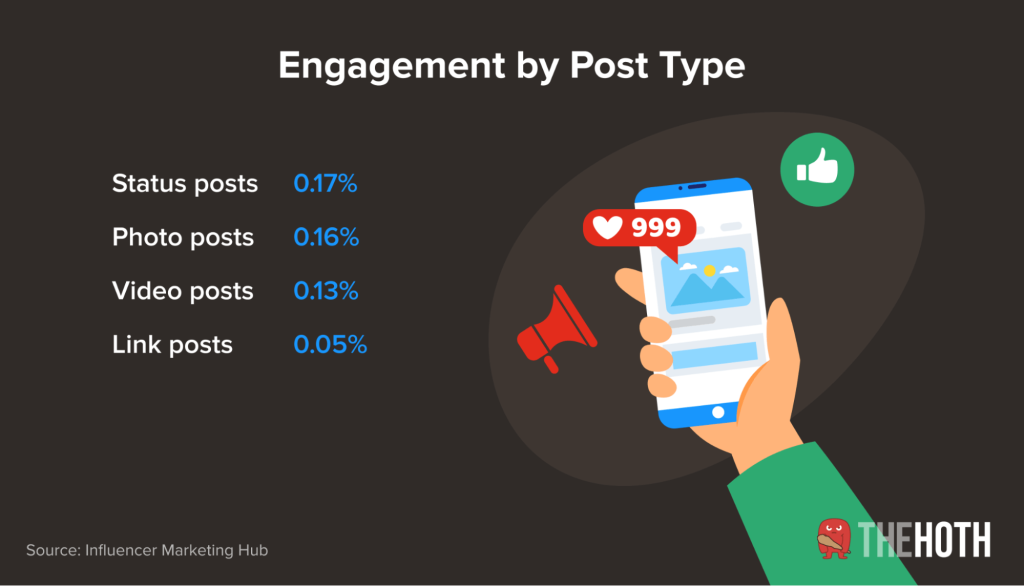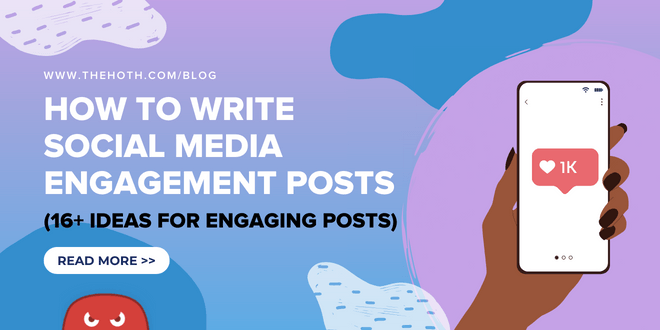
It’s no secret that social media platforms like Facebook and Instagram are goldmines for marketing, with a whopping total of 4.95 billion active users worldwide.
Since 60% of the global population is on social media, it’s no wonder that almost 93% of marketers will leverage these platforms in 2024.
While registering and setting up a profile on social media is easy, crafting content that goes viral amongst your target audience is a different story.
How can companies, especially smaller businesses, ensure their voices are heard by the right people?
The answer is to invest a lot of time and effort into creating social media engagement posts.
Bear in mind that these aren’t your average posts that blatantly promote your products and services.
Instead, they’re specifically designed to foster interaction and engagement with your brand – building brand awareness and establishing your brand as an authority figure in your industry.
In this article, we’ll teach you how to develop exciting social media engagement posts that your audience craves, so stay tuned to learn 17 easy ideas for attention-grabbing posts.
What Are Social Media Engagement Posts and Why Do They Matter?
A social media engagement post is a piece of content crafted to encourage maximum interaction on social platforms – such as likes, comments, shares, and clicks.
Engagement posts are great because they’re a step beyond passive viewing. Instead of simply consuming your content, users are encouraged to engage with your brand. This usually takes the form of:
- Leaving a comment so the audience member can share their two cents on a topic (which you can encourage by saying something like, “what are your thoughts on the issue? Let me know in the comments!”
- Liking the post due to the quality and helpfulness of the content.
- Sharing the post on their feed to expand your content’s online reach.
The average user spends 2.3 hours on various social media platforms each day.
That means if you want to reach your prospects, you have to be wherever they are, and they’re definitely on social media.
Engagement posts are key to capitalizing on each prospects’ daily time on platforms like X, Facebook, Instagram, and TikTok.
Here are the top benefits of social media engagement posts:
Increased visibility: Engagement posts signal to Google’s algorithm that your content is valuable, accurate, and high-quality. As a result, your content will start ranking higher on its search result pages.
Build a community: Social media engagement posts lead to thought-provoking conversations, new relationships, and brand loyalty. Before you know it, you’ll have a loyal following of brand ambassadors (which means they actively promote your brand because they’re fans).
Drive traffic and conversions: Engaging content will direct users to your website’s landing pages, increasing the chances of generating sales or sign-ups.
Boost brand awareness: Relevant, entertaining content that sparks discussion gets shared the most, expanding your brand’s online reach as a result.
Feedback and insights: One of the biggest perks of engagement posts is they shed light on what your audience views as valuable, which is extremely useful information for your marketing campaigns.
Enhance social proof: The more likes and shares you get, the more it’ll be clear to new prospects that your brand is the real deal.
What’s the Best Social Media Platform for Engagement?
There are tons of social platforms out there, so which should you prioritize when creating engagement posts?
Surprisingly, Facebook is still the king of social media worldwide, with roughly 3.05 billion active monthly users during Q3 2023.
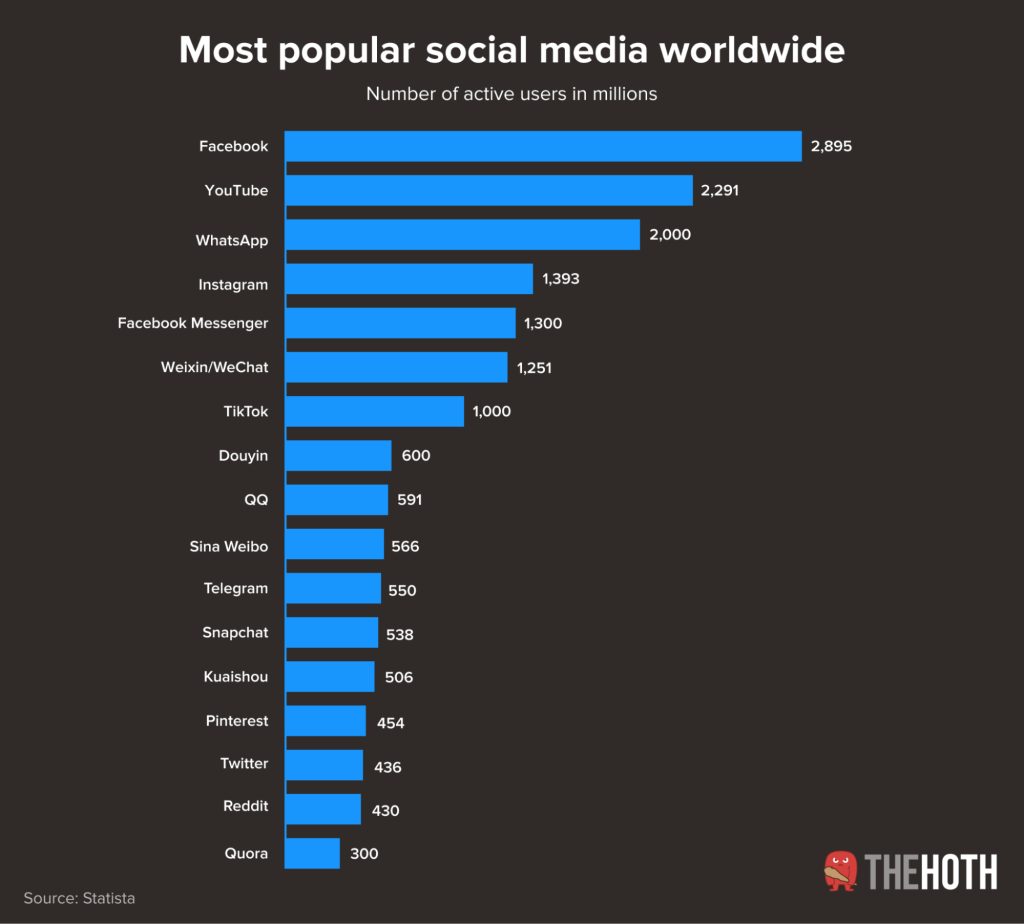
As a result, Facebook is also the most popular channel for marketing teams. A global survey showed that 89% of marketers used the platform to promote their business.
While this is still more than any other platform, it’s down from 93% in 2021. That means the social media landscape is changing, which is something you need to consider.
WhatsApp now ranks as the second most popular social media app in 2024. While initially known for personal messaging, the launch of WhatsApp Business in 2018 made it a powerful marketing tool for brands.
As of June 2023, WhatsApp Business already boasts over 200 million monthly users.
Of course, we have to mention the elephant in the room, which is TikTok.
While Facebook may have more active users, TikTok is the most frequently used app worldwide.
The proof?
Android phone users spend an average of 34 hours a month on the platform, which beats Facebook’s monthly average of 20 hours.
Also, TikTok has much higher engagement rates for its organic posts. In 2021, micro-influencers saw a completely unheard-of 17.96% organic engagement rate.
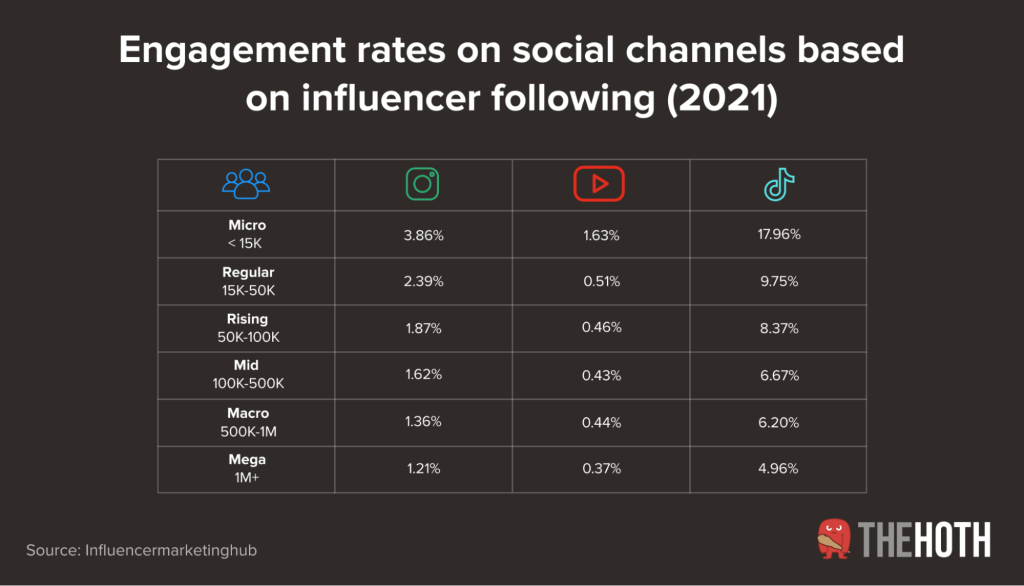
Yet, the social platform that you should focus on the most depends on your target audience’s demographics.
Even though TikTok boasts more engagement and time spent on the platform than LinkedIn, the latter remains the preferred marketing channel for B2B companies (since LinkedIn has an older, more professional demographic).
TikTok is the perfect platform if your business targets a younger crowd, as two-thirds of its users are between 18 and 34 years old.
Not on all of these important platforms yet?
We can help with that. HOTH Lock My Brand registers your brand name on all the top social sites in the world.
How to Write Engaging Social Media Posts
Just because you post something on social media doesn’t mean that it will receive engagement.
Instead, it takes a special type of post that’s been handcrafted to foster engagement from your audience.
Here are our top 9 tips for creating social media posts that get your audience talking.
1. Know Your Platform
As stated before, the social media landscape is evolving, and marketers are now turning to new platforms.
For this reason, it’s pivotal to understand the platform you’re currently using, as it may look different than it did just a few years ago (in terms of demographics, features, functionalities, etc.).
First, you need to know the type of engagement you’re trying to elicit.
Do you want to get shares on Facebook or are you hoping to get duets and stitches on TikTok?
Moreover, you should educate yourself about the platform’s algorithm to learn how it decides which content to show to whom.
After all, SEO is all about mastering Google’s algorithm to ensure better visibility, so why not learn the ins and outs of your preferred social platform’s algorithm to do the same thing?
For example, X populates users’ feeds with posts from the accounts they interact with the most, while YouTube makes recommendations based on topics the user likes.
The more you know about a platform’s algorithm, the easier it will be to optimize your content for your specific audience.
2. Discover What Works
Social media supports numerous types of content, from video campaigns to infographics and beyond.
Because of this, you need to determine which type of content generates the most interest from your audience.
Every demographic is unique, and the best way to find out what resonates with them is to track your posts’ engagement levels and then analyze the data.
Most platforms have some way to monitor your metrics, such as viewing how many followers you have or how many users watched one of your videos.
To dive deeper into data analytics, you can invest in a social listening tool.
What’s that?
A social listening tool gathers information from various social platforms and websites online, including Facebook, X, Trip Advisor, and many others.
You can set up custom listening campaigns for specific keywords and topics, such as:
- Your industry
- Your brand
- Your competitors
From there, you’ll be able to ‘listen in’ on the entire social conversation surrounding things like your brand and industry, which is great for uncovering opportunities for engagement.
Here are a few examples of popular social listening tools:
3. Develop a Brand Voice
Is your content formal and professional or casual and trendy?
Do you sound like you’re 25 or 55?
Does your brand have a sense of humor?
Answering these types of questions will help you develop your brand voice.
A consistent brand voice aids with social media engagement because followers feel like they know you.
You’re the funny friend, the helpful expert, or the stylish trendsetter who keeps appearing on their social media feed.
Also, ensure that your posts are as relatable as possible by sharing first-hand experiences, using humor, and even referencing movies and TV shows.
That will show that your content was written by a human and not automatically generated by AI.
However, your brand voice isn’t something you can create by yourself, as it should be based on what your target audience likes.
Document the rules for your brand voice so that different employees can learn how to take the same tone in social media posts. In other words, you need to develop a style guide.
Key Point: Style guides are documents that outline parameters for things like brand voice, tone, and writing style. Here are a few examples of brand guidelines you could possibly include in yours:
|
4. Visuals are key
Humans are visual creatures, which is why posts with images and videos foster way more engagement than posts with only static text and links.
Social video accumulates 1,200% more shares than text and images combined, which is significant, to say the least.
It should come as no surprise that 88% of marketers claim video is integral to their marketing strategies.
Certain engagement posts naturally include images or videos, but that’s not always the case.
If your post isn’t inherently visual, that doesn’t mean you don’t have to make it eye-grabbing.
For instance, let’s say that you’re sharing a blog post through one of your social media accounts. Don’t just drop the link, as that’s too static and easy for people to ignore. Include a relevant, high-quality image that relates to the blog’s topic.
This tiny gesture is enough to make your post stand out and entice your audience to click the link.
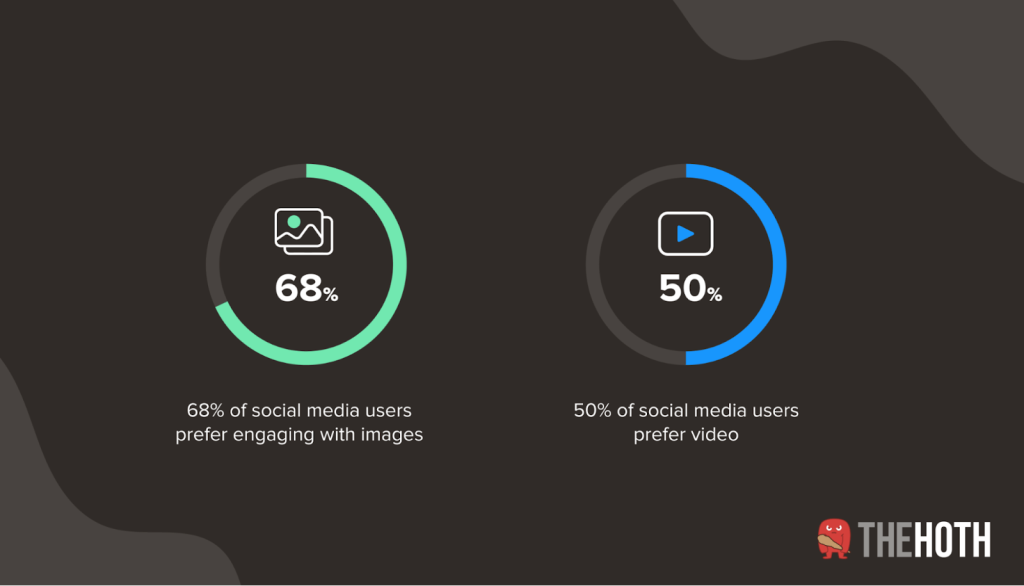
5. Jump on current trends (carefully)
No matter your platform of choice, one fact remains true: social media runs on trends.
A clever hashtag or challenge can fill up every user’s feed for a week or two—and joining the trend can boost your brand’s visibility.
Try to find ways to organically (or humorously) interject your brand into a breaking news story or viral social media trend.
Avoid getting too controversial here, as you should keep things light-hearted and fun.
6. Listen to Your Audience
One of the best things you can do to elevate your brand is talk with members of your target audience – but more importantly – listen.
The same applies if you’re interacting with your audience on social media.
However, we’re not just talking about paying attention to what prospects have posted on your profiles and in your comments.
Instead, we’re talking about mentions of your brand that occur outside of your profile, which is where the aforementioned social listening tools come into the picture.
Of course, you could always simply search for your brand name on a platform like Facebook or Instagram, but that will only provide surface-level insights.
Tools like Hootsuite and Sprout Social go far more in-depth with social listening, as you’ll have access to pretty much every mention of your brand that happens online.
Whenever you find positive mentions of your brand, don’t just give yourself a pat on the back and call it a day. Instead, be proactive and reach out to the user to thank them for their kind words (to go the extra mile, you could even share some of their content on your profile).
If the mention is negative, you should still reach out.
However, instead of giving them an honest piece of your mind, you should let the user know that you appreciate the feedback and will consider it in the future. If they’re experiencing issues with a product or service, get them in touch with customer support and follow-up at a later **** to ensure that everything gets resolved.
Social listening is a powerful tool, which is why 71% of companies find value in monitoring social media. The valuable customer insights you gain from it will benefit numerous departments in your business (like sales, marketing, and even HR).
7. Pay Attention to Influencers in Your Niche
Which creators and influencers are popular in your niche, and what are they posting about?
If an influencer is getting great engagement talking about products similar to yours (or posting content related to your industry), you should learn from their success.
Besides taking notes on what they did right, you can also reach out to them with the hopes of building a relationship. That way, they could potentially promote your products and services in the future.
How do you do that?
The best way to start is to engage with their posts and share their content. After you’ve established a rapport (and hopefully received a few replies in the meantime), you can bring up the idea of partnering with them.
This will also put you in front of their followers. If you find a creator whose content is likely to resonate with your audience, reach out to them about working together.
For example, Subaru reached out to multiple influencers with its #MeetAnOwner campaign (geared toward promoting the Impreza hatchback), which had fantastic results. In one instance, a popular YouTuber filmed himself and friends shooting off a slip-and-slide that propelled them off a 500-foot cliff (while highlighting the Impreza along the way).
The video generated 1.3 million views for Subaru and provided serious entertainment value.
8. Post at the Right Time
There’s no single “perfect” time to post on social media that guarantees success, but there are undoubtedly better times than others (depending on the needs of your demographics, of course).
The best times depend on several factors:
Studies show that Tuesdays, Wednesdays, and Fridays from 9:00 to 10:00 AM tend to see good engagement across most platforms.
You should avoid late ****** and weekends, as engagement generally dips during those times due to people sleeping, running errands, and enjoying time off work.
Here are the factors that influence the best times to post:
⏰ Your target audience: Where are they located? When are they most likely to be online? Don’t forget to consider time zones because they can completely throw off your game. For instance, if your work is located in the central time zone but most of your audience lives in California, you’ll need to calculate the difference whenever posting content – or you could wind up posting two hours earlier than you intended.
⏰ Platform: Each platform has its own peak usage times. For example, LinkedIn sees more engagement during business hours, while Instagram might be more active in the evenings. Most millennials admit to browsing social media whenever ads play on TV or streaming services, so the evening (after work hours) is a good time to post new content.
⏰ Industry: B2B audiences may be more active on weekdays during work hours, while consumer-focused brands may see better results on weekends. However, you should confirm this with data first. Some audiences may limit their social media use on weekends due to traveling or errands, so you should never make assumptions.
⏰ Your own data: Most social media platforms provide analytics, which you should definitely capitalize on. Track when your posts historically get the most engagement, and you’ll uncover the perfect times to post new content.

9. Cross-promote social media profiles
At this point, most people are on multiple social media platforms (if not all of them).
As such, don’t be afraid to post a “Follow us on Instagram” on X or vice versa.
Your followers may be more interested in engaging on one platform than another, so cross-promoting your accounts gives them options.
Plus, you’ll be posting different types of content on each one, which increases your chances of seeing more engagement.
Also, your website is prime real estate for promoting your social accounts, so don’t forget to include social buttons where your audience can clearly see them. Most websites stick with the very top or left-hand side of the page since they naturally attract the eyes.
17 Creative Social Media Engagement Post Ideas to Captivate Your Audience
At its core, a social media engagement post can be anything that entices users to interact with your brand.
If that seems extremely broad, it’s because it is.
Fear not, as there are some tried-and-true content formats for encouraging interaction.
Here are 17 battle-tested ideas for engagement-boosting posts.
1. Ask a Question
The concept is simple: you want people to reply to your post, so you give them a question to answer.
It doesn’t have to be complex, but it’s best if it’s related to your industry or the habits of your target audience.
Why it matters
- Generates comments. Asking a question is one of the most effective ways to get your audience talking in the comments section.
- Discussions build a sense of community. Once you get your audience talking, it will start to build a sense of community amongst your fans.
- Learn more about your audience. Ask the right questions, and you’ll learn a lot more about your follower’s preferences, needs, and pain points – all of which is valuable marketing information.
How to do it
- Stay relevant. Remember, your goal is not only to generate comments but also to learn more about your target audience. As such, your questions should remain relevant to your brand in some way.
- Use a mix of open-ended and specific questions. To get a diverse mix of responses, try using both open-ended (“what’s your dream vacation?”) and specific (“If you could add one feature to our product, what would it be?) questions. Whatever you do, avoid simple ‘yes and no’ answers like the plague.
- Make it easy. Avoid asking questions that are too complex or require a lot of thought. Your goal is to ask relevant, fun questions that you know your audience will want to respond to.
Example

2. Poll Your Followers
A twist on the question post is the poll, and it’s equally as effective at generating interaction and comments.
While polls can help you learn more about your audience, the best are typically lighthearted in nature.
For instance, asking, “Do you like pineapple on pizza?” is more likely to elicit interaction than serious market research questions (yawn).
Why it matters
- Builds brand awareness. Polls are extremely popular, and if you make a particularly interesting one, your audience will share it with their friends. This will generate more awareness for your brand, which is a plus.
- Sparks conversations. Posts that include polls are excellent conversation starters, as your audience will want to justify their choices and debate others in the comments.
- Audience insights. Even if they aren’t super deep, polls will help you gain insights about your core audience.
How to do it
- Think of a fun question to ask that has multiple answers. The question you ask needs to have several available answers, and they should vary quite a bit.
- Create a poll on your platform of choice. Nearly every social platform has the option to create a poll built-in, so you won’t have to worry about coding or using any external software. On Facebook, all you have to do is click Create Post and then select Poll from the list of options.
Example

3. “Caption This”
It’s no secret that memes are extremely popular on social media, so a great way to encourage interaction is to get your audience to create their own.
Upload a strange or goofy photo and ask your followers to add funny captions.
It’s a simple concept, but it can be endlessly entertaining and is excellent at building brand loyalty (you’re sharing laughs with your audience, which can build a lasting bond).
Why it matters
- Great use of humor. Creating memes is undeniably fun, so your audience should have a blast coming up with captions for your photo.
- It grants your audience agency. Instead of simply responding to a question or adding their two cents on a topic, ‘caption this’ posts make your audience the star of the show. Granting your audience this kind of agency will help you gain their loyalty.
How to do it
- Find a funny (non-offensive) photo. A ‘caption this’ post is only as strong as its source material, so you should hunt down a photo that’s funny, unique, or cringe in some way.
- Let your audience’s creativity take over. Once you’ve got the perfect photo, your part is done. Simply ask your audience to caption it, and they’ll be off to the races.
Example

4. Go Live
Another great way to boost engagement is to go live, or ‘doing a live’ as Vin Diesel would say.

Just like polls, most social media platforms enable you to stream live video without having to take any special extra steps.
Why it matters
-
- Audiences prefer live video. Users **** this format, as 80% of consumers prefer to watch live videos instead of reading a blog.
- You can chat with your audience on the fly. Whenever you stream live, DO NOT forget to interact with the live chat. Besides answering their questions, give individual shout-outs to each person interacting with you.
How to do it
- Brainstorm a topic to cover. You shouldn’t go live if you don’t have anything to talk about. After all, who wants to watch someone sit and twiddle their thumbs? Instead, pick one of the content topics you’ve researched (like for your blogs) and go from there.
- Use your preferred platform to stream live video. Once you know your topic, all you have to do is start a live stream on a platform like Facebook, YouTube, Instagram, or TikTok.
Example
A brand that makes excellent use of TikTok’s live streaming feature is McDonald’s, as they make frequent use of employee livestreams – like workers engaging in ‘fast food battles’ (which is where they try to outperform their co-workers).
5. AMA (Ask Me Anything)
The AMA format was popularized on Reddit. It’s exactly what it sounds like—people can ask you any question, and you answer it.
Why it matters
- Your audience learns more about you. This engagement post is a twist on the ‘ask a question’ post, as your audience gets to learn more about your brand instead of the other way around.
- It gets your audience thinking about your brand. If they want to ask a question, they’ll have to sit and think about your brand, which is what you want.
How to do it
- Create an AMA post. Just because Reddit coined the AMA doesn’t mean that they own exclusive rights to it. Regardless of your preferred social platform, you can create an AMA with ease.
- Answer every question. Once the questions are in, don’t skip any. Instead, provide a thoughtful response to everyone who has a question.
Example
Online influencer and podcaster Steve-O recently did an AMA on Reddit, and the amount of interaction he got was impressive.
6. Contest or Giveaway
There are two things that everybody loves: winning and free stuff. You can hold a giveaway for prizes, large or small.
It could be a contest, like a photo or video competition, or you could automatically enter users into a giveaway if they like you, follow you, or fill out a form. The important thing is that you clearly publicize the rules.
Why it matters
- Contests provide incentives for engagement. There are plenty of users who will scroll past AMAs, question posts, and polls without skipping a beat. Their kryptonite? Any post that has an incentive like the possibility to win something free.
- They position your brand as generous. Do your best to publicize the winners of your contests as much as you can, as that communicates to others that your brand is generous and cares for its customers.
How to do it
- Select a prize. Pick a prize (or prizes) that A) won’t blow your budget and B) are desirable enough for your audience to take part in the contest.
- Decide on the rules. Will your audience compete for something, or is it a random giveaway (like giving the prize to the 1000th person to comment)?
Example
Canva’s Design Challenge is an ongoing example of a branded contest that fosters lots of engagement.
They challenge graphic designers from around the web to come up with an impressive design (this week’s theme is a process diagram).
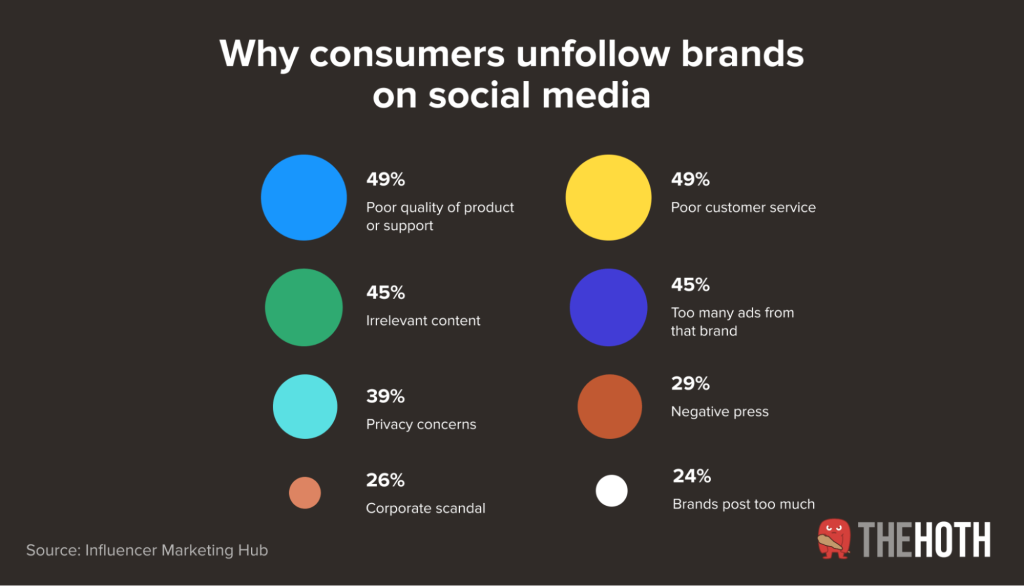
7. Expert Interview
Film a video interview with an expert in a field related to your product. This is more interesting and authoritative to users than simply promoting your products.
Why it matters
- Audiences prefer video. We’ve already gone over how users prefer video to blogs, which is why you should film your experts instead of having them write a guest post.
- Adds credibility to your brand. One of the best things you can do to build brand loyalty is to educate your audience, and expert interviews do just that.
How to do it
- Find an industry expert. It could be someone you know in the field, or they could be directly employed at your company.
- Shoot a brief yet informative video. Without going too in-depth (as that’ll bore your audience), have the expert give a brief rundown on a topic relevant to your industry.
Example
In this example, a finance expert reviews BBC’s Industry to comment on the show’s accuracy (i.e., how well it depicts the financial world).
8. Customer of the Week
Reward your fans by putting them in the spotlight. Feature a customer each week or month with a photo and a brief Q&A or story about how they use your product.
Why it matters
- Shows you care about your audience. The most loyal customers are ones who truly feel valued by their preferred brands, and choosing a customer of the week is one of the best ways to show how much you appreciate your audience.
- Builds brand ambassadors. The customers you feature will likely become loyal brand ambassadors, meaning they’ll recommend your products and services to their friends and family.
How to do it
- Find your most loyal customers. An easy way to go about this is to look at the customers who frequently post about your products.
- Reach out to them. Send your prospect an email and inform them that you’d like to include them as your customer of the week. Request a photo and a brief bio to include.
Example

9. Share a Review
If you’re getting good online reviews from customers, promote them on your social media.
But make sure you’re engaging with your audience. Thank the person who left the review and everyone else who’s taken the time to do so. You can also ask your followers to join the conversation.
Why it matters
- It provides social proof for your brand. Positive reviews communicate to your prospects that your brand is high-quality and worth their time and money.
How to do it
- Gather reviews online. If you don’t have any reviews on your Google Business Profile, check third-party sites like Yelp, Angi, and Better Business Bureau (BBB).
- Post them on your social channels. Create engagement posts highlighting positive reviews for your followers to see.
Example
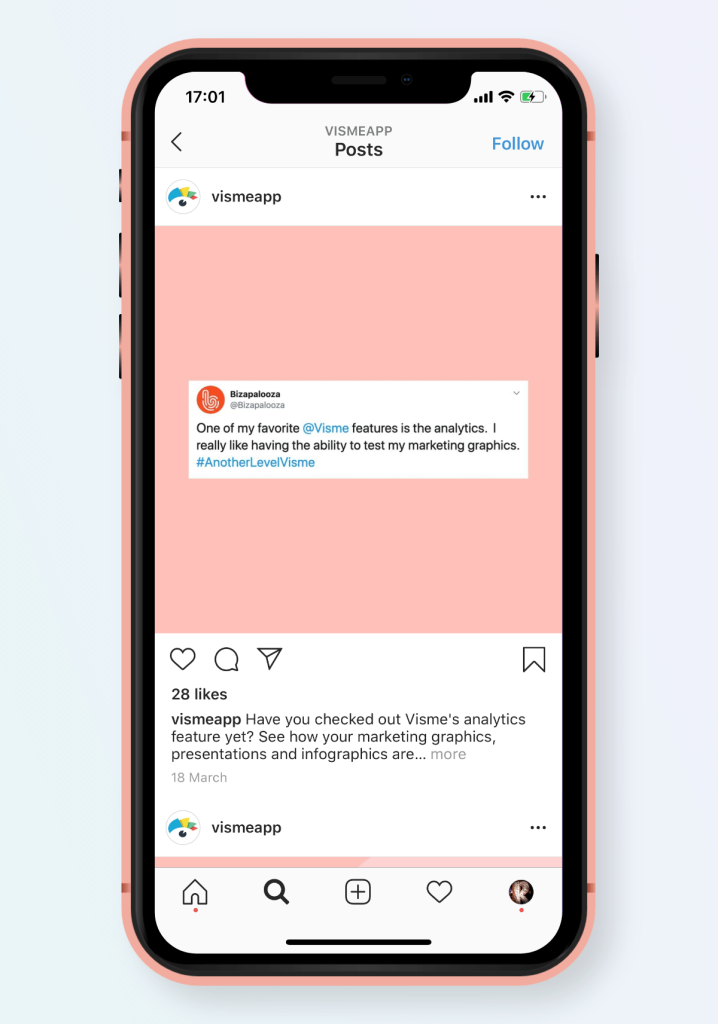
10. Introduce The Team
Your followers like to know that your organization is made up of real, relatable people. In a post, feature your team or an individual team member.
Why it matters
- Humanize your brand. Without the occasional staff profile, your audience will have no way to associate a face with the name – so to speak.
- Provide insight into your working environment. Besides getting to know the staff member, your audience will also get to peer into your work environment.
How to do it
- Select a member of your team to profile. Make sure the person you choose is comfortable with sharing their information online.
- Take plenty of pictures and videos. Static interviews are boring, so include visuals like images and videos of your office.
Example

11. Ask For Recommendations
You know how your friends are always recommending new movies and TV shows to try out?
Well, you can mimic that dynamic on social media by asking your audience to recommend their favorite books, movies, TV shows, music, and more.
Why it matters
- Build rapport with your audience. By asking your audience for recommendations, you’re showing that you care about what they think. Also, do your best to respond to recommendations that you find interesting.
How to do it
- Create a post asking your audience for their recommendations. This one’s pretty straightforward, as all you need to do is create a standard post and ask your followers for their favorite media (or whatever else you’re asking about).
Example

12. Offer a Social-Only Deal
Who doesn’t like a good deal? Promote a special offer that shoppers can only take advantage of if they like, follow, or comment on social media.
Why it matters
- Expand your reach. There are some users that simply can’t resist a deal which will help you expand your reach to new prospects.
- Engagement is guaranteed. Your followers will only receive the deal if they interact with your brand in some way, so you’re guaranteed to see more likes, follows, and comments.
How to do it
- Choose a special offer. First, you need to determine what type of deal you’ll offer your audience. It should be enticing enough to elicit interaction while not draining your budget (or affecting your profit margins).
- Inform your followers of the special deal. Besides informing your followers that the deal is active, don’t forget to include detailed instructions on what they have to do to receive it (such as tagging a friend or commenting something specific).
Example
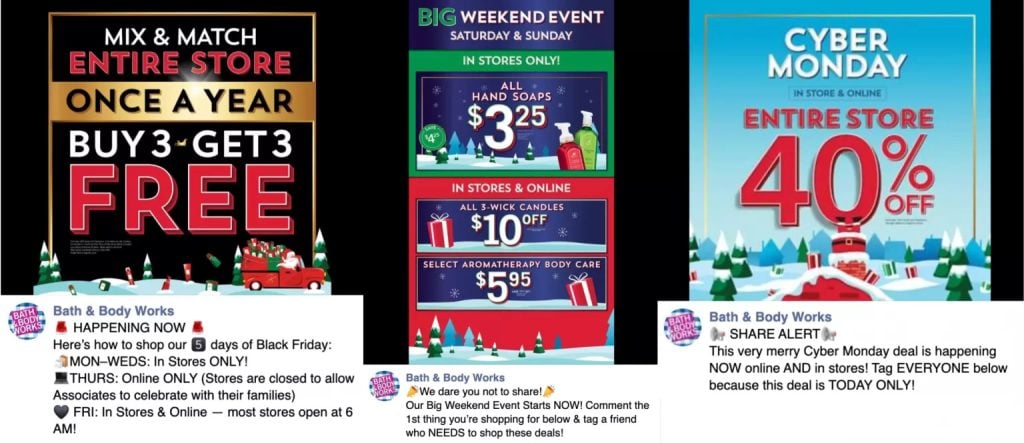
13. Share Something (Mildly) Controversial
We’re not recommending that you wade into the realm of political debates. You can stir up a little controversy while keeping it lighthearted and fun.
A funny “unpopular opinion” post is sure to get people talking, even if it’s about something trivial — like how winter is the best season.
Why it matters
- Catch your audience’s attention. With a slightly controversial take, you’re more likely to raise some eyebrows and get people to stop endlessly scrolling.
- Foster a lively debate. Another perk is that you can spark a lively conversation in the comments, as your followers will be eager to state their side (and why it’s right).
How to do it
- Select a *** take that’s not too ***. Keep things light-hearted but don’t shy away from truly controversial topics (as long as they aren’t too political).
- Encourage your followers to take it from there. Once you’ve introduced the topic, your job is done. All you have to do now is monitor the discussion and add your two cents wherever necessary.
Example
Ben & Jerry’s are notorious for their stance on sustainable and organic food solutions, which is a controversial take – but also made their brand famous since they don’t skimp on quality and refuse to use artificial ingredients.
14. Post a challenge
Do you remember the viral ALS ice bucket challenge of yesteryear? There are new challenges trending on social media every day, and they present engagement opportunities for your brand.
Why it matters
- Challenges attract a lot of attention. Social media challenges blow up all the time, such as the infamous ALS ice bucket challenge. You never know when the next challenge you participate in will take off – so stay vigilant.
How to do it
- Monitor social media trends. Trends and challenges pop up all the time, and keeping up with them can feel next to impossible. Luckily, there are online resources like Slaying Social that keep up with the trends for you.
Example
Chipotle makes excellent use of social media challenges, and they’re coming up with new ones all the time.
A notable example was the Lid Flip Challenge featuring YouTube influencer David Dobrik.

15. Post valuable content
If you truly want to build an audience that sticks by your brand, you need to regularly publish content that informs, educates, entertains, and solves problems.
Why it matters
- Builds trust. Your audience will appreciate that you always solve their problems, so your brand will be the first place they look whenever they experience a new issue.
- Keeps followers coming back. Remaining consistent with your content efforts will keep your readers coming back for more.
How to Do It
- Learn your audience’s pain points and interests.You should always be monitoring your audience’s social discussions to learn more about their wants, needs, and pain points.
- Share industry insights, tips, and tutorials. The more accurate and informative your content is, the better.
Example

16. Post timely content
Don’t shy away from posting about time-sensitive events like new store openings, concerts, and notable news stories.
The content may not be evergreen, but you’ll capitalize on viral news stories and generate more traffic.
Why it matters
- Boosts visibility. You’ll improve visibility for audience members searching for time-sensitive events.
- The ability to participate in broader conversations. The world is a fast-moving place with tons going on at once, so posting timely content will enable you to participate in broader conversations.
How to do it
- Hashtags. Follow trending hashtags and news relevant to your industry.
- Content based on trends. Create quick, reactive content (memes, image posts) related to trends.
- Consider holidays. Plan ahead for holidays and major events.
Example

17. Post high-quality photos
The quality of your photos is extremely important, especially if you want to boost engagement.
You should only use visually appealing images that are perfectly composed, feature impeccable lighting, and pertain to the topic at hand.
Why it matters
- Catches the eye. Above all else, you want your followers to stop scrolling and pay attention to your content, and high-quality photos are great for that.
- Boosts professionalism. Your audience will correlate the quality of your images with your brand (whether they realize it or not), which is why immaculate images are a must.
How to do it
- Invest in good photography equipment or work with a photographer. Original images will have more impact than stock photos, so look for a reputable photographer.
- Use photo editing apps to adjust brightness, colors, etc. Taking a solid photo is only half the equation, as you’ll want to edit it to perfection.
Example

Final Thoughts
These tips are your roadmap to creating social media content that truly connects with your audience.
But let’s be honest – social media is just one piece of the puzzle.
There’s SEO, paid advertising, content creation…a complete digital marketing strategy demands a lot!
Imagine having more time, resources, and expert guidance to amplify your digital marketing results across the board. Let us take those worries off your plate and simplify your SEO success.
Schedule a call with a HOTH marketing expert today, and let’s revolutionize your social media presence!
